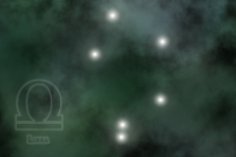
Exactly. The constellation Libra—the only one in the zodiac that is not a being but an object—was added to the list quite late. And in Ptolemy's catalog, its place is taken by the “Claws of Scorpio.” But there were other representations, too: sometimes as an altar, sometimes as a lamp clasped between those very claws. Ultimately, they all converged on the image of the scales. Why?
The autumnal equinox point was once located not in the constellation Virgo, but in Libra. Virgil reported this in the first century BCE: “When Libra equalizes the hours of day and night and divides light and darkness equally, then, farmers, lead your oxen into the fields.” And the ancient Egyptians used the current sign of Libra to guide their harvest, though not when the Sun would be in Libra, but when the Sun itself would appear in the night sky at the end of spring.
Ancient times left us with the myth of Libra.
It is said that Zeus himself cast them into the cosmic heights. The Thunderer entrusted his daughter Astraea, born of Themis and the goddess of justice, with watching over the world of men and assessing the righteousness of their deeds. Every year, she descended to earth, blindfolded and holding scales, weighing the deeds of men. The results of the measurements were reported to her father so that he would be informed, and those guilty of sins were punished.
Distressed by the decline in morals, which her measuring instrument showed as an ever-heavier skew toward evil, Astraea ended her inspections and departed into space—away from the sinners—and there appeared as the constellation Virgo. Her distraught parent sent her instrument after her, and they have remained side by side ever since.
However, according to alternative versions, the stellar Libra is an attribute of Themis, the goddess of justice; Nemesis; Adrastea; Dike – all of whom, to one degree or another, were associated with the idea of justice.
What does modern science say about this constellation?
Libra, occupying an area of 538.1 square degrees, is adjacent to Virgo, Ophiuchus, Scorpio, Lupus, and Serpens. Its brightest star, Kiffa (a), forms an equilateral triangle with Spica and Arcturus. However, Kiffa is also known by many Arabic names, including Zuben Elgenubi; Zuben el Genubi; Zuben el Genoubi; Zuben el Genoubi; Zuben al Genoubi.
But the biggest news scientists have about Libra is that for the first time, a planet similar to Earth has been discovered within its orbit. And this despite the fact that the space around 1,500 stars has already been surveyed! So what is this discovery?
It's located 20 light-years away and only one and a half times the size of Earth. It's believed to contain water, with temperatures ranging from 0 to 40 degrees Celsius and a surface filled with oceans and rocky soil.
To further study this celestial body, astronomers plan to launch a telescope into orbit that will search for methane (emitted by living organisms) and chlorophyll (a key element in photosynthesis) in the atmosphere of this supposed relative of our planet. If the search is successful, it will allow us to speak with greater confidence about the possibility of life on this cosmic orb.





